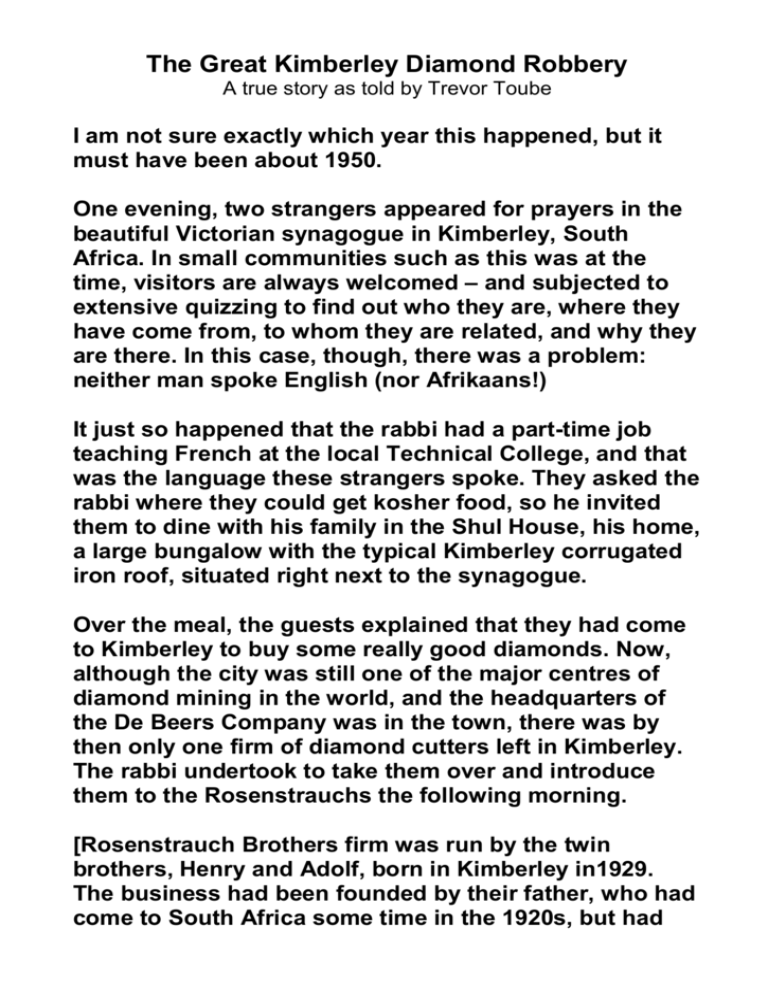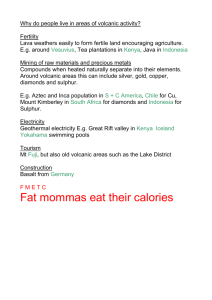The Great Kimberley Diamond Robbery
advertisement

The Great Kimberley Diamond Robbery A true story as told by Trevor Toube I am not sure exactly which year this happened, but it must have been about 1950. One evening, two strangers appeared for prayers in the beautiful Victorian synagogue in Kimberley, South Africa. In small communities such as this was at the time, visitors are always welcomed – and subjected to extensive quizzing to find out who they are, where they have come from, to whom they are related, and why they are there. In this case, though, there was a problem: neither man spoke English (nor Afrikaans!) It just so happened that the rabbi had a part-time job teaching French at the local Technical College, and that was the language these strangers spoke. They asked the rabbi where they could get kosher food, so he invited them to dine with his family in the Shul House, his home, a large bungalow with the typical Kimberley corrugated iron roof, situated right next to the synagogue. Over the meal, the guests explained that they had come to Kimberley to buy some really good diamonds. Now, although the city was still one of the major centres of diamond mining in the world, and the headquarters of the De Beers Company was in the town, there was by then only one firm of diamond cutters left in Kimberley. The rabbi undertook to take them over and introduce them to the Rosenstrauchs the following morning. [Rosenstrauch Brothers firm was run by the twin brothers, Henry and Adolf, born in Kimberley in1929. The business had been founded by their father, who had come to South Africa some time in the 1920s, but had subsequently been persuaded to return to his native Belgium. When the Nazis invaded Belgium, as his wife, Gladys told my mother, “We ran, with just the clothes we stood up in.” (These clothes appear to have included two fur coats!) They also filled their pockets with diamonds, and lived on the proceeds of their sale.] The next day the rabbi collected the two strangers and drove over to the diamond-cutting works. There Henry showed them what he had in stock and the visitors selected a few stones of high quality and considerable value. Now, one would not of course be carrying around large sums in cash on the off-chance of finding suitable gems for purchase, and clearly a cheque with no backing would not do. In such cases, there is a clear procedure. The diamonds are folded into a special ‘diamond paper’ and placed in a stout envelope. Both parties to the sale examine the seal carefully and both sellers and purchasers sign across the seal. The buyers can then go away to raise the required money, secure in the knowledge that the stones cannot be exchanged for any others. And that was what was done. That night, just as the rabbi was about to doze off, he suddenly had a thought. Had he – or had he not – noticed that while examining the seal on the envelope, one of the visitors substituting for the envelope an identical one he’d removed from the breast pocket of his jacket? The more he thought about it, the more convinced he became that an exchange had in fact taken place. What should he do? He got out of bed and telephoned the Rosenstrauchs. Now, there was a problem: at this time, phonecalls went via an operator at the exchange, so he could not say too much in case the operator happened to overhear his comments. He explained that he needed to speak to them about that morning’s events and arranged to meet them at the cutting works. When they got there, the brothers opened the safe and took out the envelope. They felt it with their hands and noted the there were the expected number of hard objects within. But they could not, of course, open the envelope to check, because, if the diamonds were in fact inside, when the buyers came back to collect them, they might legitimately suspect that the gems had been replaced by inferior stones and a valuable sale would have been lost. There was, however, a possible solution. Diamonds are made of pure carbon, and carbon is a light element (Atomic Number 6), which means that they are essentially transparent to clinical X-rays, whereas stones are opaque to X-rays, so all that was required was an X-ray of the envelope and the answer would be known. X-ray? Hospital!! The Chief Surgeon of Kimberley Hospital was Noel Kretzmar, one of the rabbi’s prominent congregants [and a near neighbour of mine; his daughter, Geraldine (Auerbach) was the founder of the Jewish Music Institute in London]. So off they went to rouse Noel from his bed. Once they had explained their dilemma, Noel was very sympathetic – but explained that the X-ray Department at the hospital was closed at night so that nothing could be done until morning. Then he remembered: his brother, Dr Julius Kretzmar, had a small X-ray apparatus at his consulting rooms in DuToitspan Road. He phoned Julius. Cautiously (in case the operator was listening in to this phonecall between two of the prominent medical men of the city), he said, “Julius, I have someone here and I suspect he may have some stones. May we meet you at your rooms so I can take an X-ray” – and off they all went! At Julius’s consulting rooms in ‘Pan Road they found the doctor waiting for them, with the machine already switched on and warming up. He was expecting … someone with a suspected kidney stone? – gall stones? – certainly not a brown envelope! The situation was explained to him, the X-ray was duly taken and the film developed. And it showed several dark shadows! The envelope contained pebbles, not diamonds. The seal was torn open and the truth confirmed. At once the police were informed. A watch was placed on all ports and airports to intercept the perpetrators. It was all in vain. They had already left the country. Some years later, one of the men was arrested in South America and deported to France, where he was wanted for some similar crime. Henry was flown to Paris to see if he could identify him – at the expense of the South African Police if it was in fact one of the thieves, but if not the Rosenstrauchs would have to pay. The identification was positive …. but no diamonds were ever recovered.



